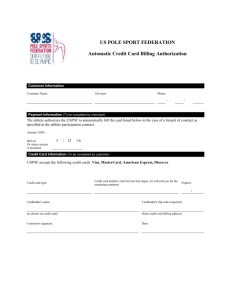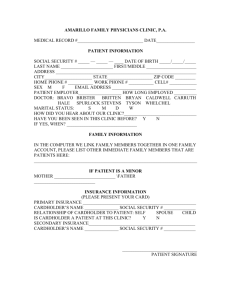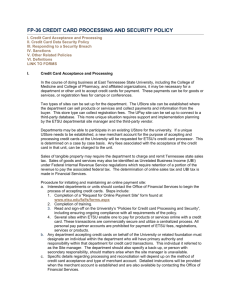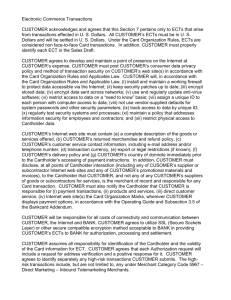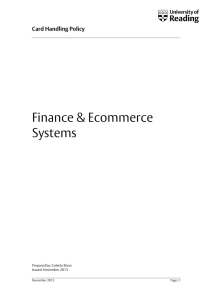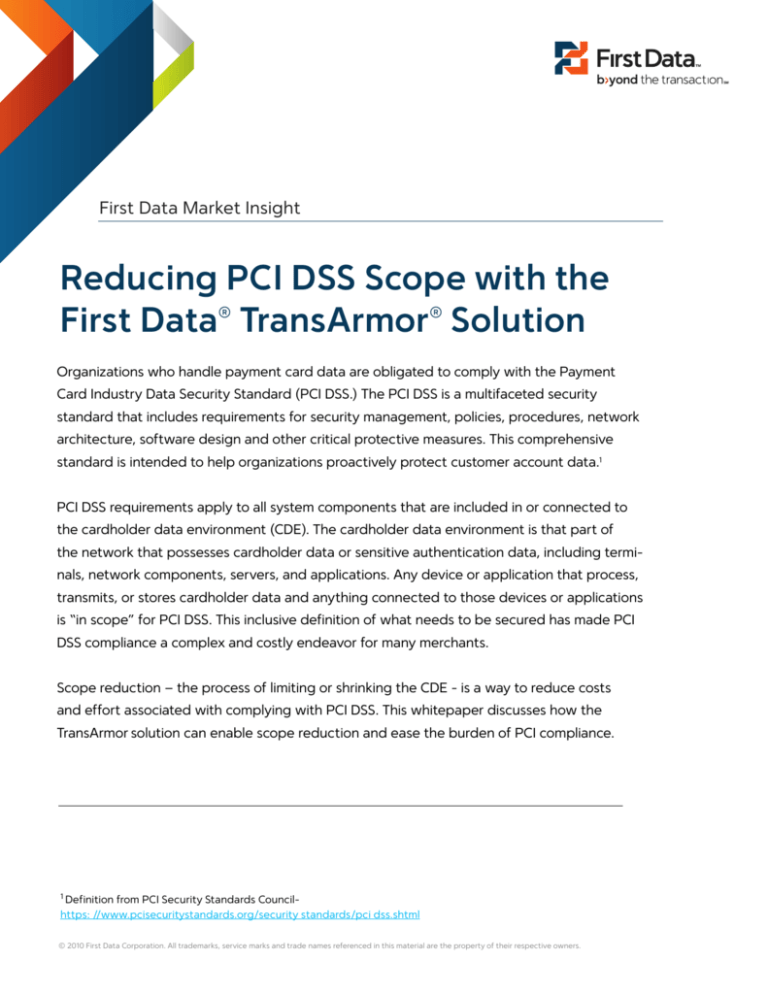
First Data
Market
Insight
First Data
Market
Insight
Reducing PCI DSS Scope with the
TransArmor
Solution ® Solution
First Data® TransArmor
SM
Organizations who handle payment card data are obligated to comply with the Payment
Card Industry Data Security Standard (PCI DSS.) The PCI DSS is a multifaceted security
standard that includes requirements for security management, policies, procedures, network
architecture, software design and other critical protective measures. This comprehensive
standard is intended to help organizations proactively protect customer account data.1
PCI DSS requirements apply to all system components that are included in or connected to
the cardholder data environment (CDE). The cardholder data environment is that part of
the network that possesses cardholder data or sensitive authentication data, including terminals, network components, servers, and applications. Any device or application that process,
transmits, or stores cardholder data and anything connected to those devices or applications
is “in scope” for PCI DSS. This inclusive definition of what needs to be secured has made PCI
DSS compliance a complex and costly endeavor for many merchants.
Scope reduction – the process of limiting or shrinking the CDE - is a way to reduce costs
and effort associated with complying with PCI DSS. This whitepaper discusses how the
TransArmor solution can enable scope reduction and ease the burden of PCI compliance.
1 Definition
from PCI Security Standards Councilhttps: //www.pcisecuritystandards.org/security standards/pci dss.shtml
© 2010 First Data Corporation. All trademarks, service marks and trade names referenced in this material are the property of their respective owners.
First Data Market Insight
®
®
The First
Data TransArmor
solution
delivers
strong data
security toasmerchants
as part
a service
as part of
TransArmor
solution delivers
strong
data security
to merchants
a service as
of processing
processing
payment
card transactions.
solution incorporates
encryption
and tokenization
technologies
payment card
transactions.
The solutionThe
incorporates
encryption and
tokenization
technologies
to protect to
protect
card data.
sensitivesensitive
paymentpayment
card data.
Following is an overview of how the TransArmor secure transaction management service works in a card-present
environment:
1.
When a purchase is made, the payment card number is captured and encrypted at the
merchant’s point of sale (POS) terminal. The TransArmor software on the merchant’s POS
terminal handles the encryption, which is asymmetric, meaning different keys are used for
encryption than for decryption.
2. The encrypted card data is transmitted over secure networks to First Data.
3. First Data decrypts the Primary Account Number (PAN) using a secure private key.
4. First Data presents the merchant’s transaction to the payment card brands (i.e., Visa, MasterCard,
MAC, etc.) for authorization. Simultaneously, First Data checks the PAN against a table
previously processed payment cards to see if a token number has already been assigned to the
card number. If so, the existing token number assigned to that card is reused. If the payment
First Data TransArmor Secure Transaction Management Service: How it Works
Merchant Environment
First Data
Data Center
1
2
3
4
PKI encryption
Merchant
First Data Switch
6
Financial token
Merchant
6
Issuer
5
Token Number
Assigned
4
Transaction log
settlement
data warehouse
6
SafeProxy
Server
6
Analytics
Merchant
Anti-fraud
Merchant
© 2010 First Data Corporation. All rights reserved.
firstdata.com
page 2
First Data Market Insight
card hasn’t been previously presented to First Data, then a new token number is randomly
assigned to the PAN, and First Data logs which token corresponds to the new PAN for future
transactions. First Data re-encrypts the PAN and stores it as ciphertext within a highly secure
data vault.
5. First Data returns the payment authorization and the token number for the card to the
merchant’s POS, where the information is stored with related transaction and cardholder data
(i.e., SKUs for items purchased, cardholder name).
6.
The merchant uses the token number in other business processes, such as sales auditing,
marketing analytics, loss prevention auditing and customer loyalty programs. Subsequent payment
transactions, such as adjustments, refunds, “card not present” payments and delayed settlement,
can also use the token in place of the card number.
Scope Reduction Drivers
On January 22, 2010, the PCI Security Standards Council (PCI SSC) provided guidance on the question “Is
encrypted cardholder data considered cardholder data that must be protected in accordance with PCI DSS?”
(Article #10359). The PCI SSC stated, “encrypted data may be deemed out of scope if, and only if, it has been
validated that the entity that possesses encrypted cardholder data does not have the means to decrypt it.”
Therefore, if a merchant encrypts cardholder data but does not possess the means to decrypt it, the cardholder
data is not considered in scope once it has been encrypted.
Typically, merchants operating in-house encryption systems for payment card data don’t benefit from reduced
PCI scope, because the appiications and systems that use the card data must decrypt it to make it readable
and usable. To take their encrypted card data environments outside the scope of PCI review, merchants must
contract key management to an outside party, which, in turn, must prove it’s able to protect cryptographic keys
in accordance with industry best practices such as those specified by the NIST or in the PCI DSS.
The specific implementation of the TransArmor solution has several elements which enable users to remove card
data from PCI scope. The use of public key encryption is one enabler. Track data is encrypted with the Public
Encryption Key at the terminal and only the corresponding Private Encryption Key can be used to decrypt this
data. Since the Merchant does not possess the Private Encryption Key, the Merchant “does not have the means to
decrypt it.” Per the PCI SSC guidance, this data, once encrypted, can be considered out of scope.
Tokenization of PAN data is the main enabler for scope reduction. The use of tokens for post-authorization
operations (returns, chargebacks, recurring payments, sales reports, analytics or marketing programs) reduces
the instances of storage of the PAN and takes applications and systems for these business processes which
previously required PAN data out of scope as well.
Another benefit of the TransArmor solution is that the payment processor is the only entity that the Merchant
shares cardholder data with. The central database storing PANs and the systems with access to that database
all reside outside the merchant’s environment, meaning the service provider, not the merchant, bears the burden
of proving adequate security for those systems. Since no cardholder data is being returned to the Merchant, any
Service Providers that use the tokens for other business purposes or stores data for the Merchant would not be
in scope.
© 2010 First Data Corporation. All rights reserved.
firstdata.com
page 3
First Data Market Insight
With these concepts as a base, we will now look in detail at how use of the TransArmor solution may affect
the completion of PCI DSS compliance questionnaires.
Affected PCI Requirements - SAQ-D
SAQ stands for “Self-Assessment Questionnaire”; SAQs must be completed by Merchants that are not
required to undergo an on-site data security assessment and may be required by the merchant’s acquirer
or payment brand. Version D of the SAQ applies to Merchant who store cardholder data in electronic form.
The SAQ-D contains the same requirements that the PCI DSS Audit Procedures contain, so this analysis also
pertains to Merchants that are required to have an on-site PCI DSS assessment by a QSA.
The common layout of an SAQ-D Merchant performing card-present transactions, and the one that we’ll
focus on here, is a PED terminal that is physically connected to an Electronic Cash Register (POS) that is
logically connected to a Controller somewhere in the store by switches, routers and/or firewalls. The credit
card is swiped at the PED terminal, which then sends the transaction data to the ECR, which then sends
the transaction data to the Controller, which then sends the transaction data to First Data. This is illustrated
below.
Authorization Request
Card Data
(Encrypted)
Card
Data
POS and PED
Card Data
(Encrypted)
Store
Controller
Token
Card Data
Switch
Token
Token Server &
Card Vault
Authorization Response
Databases
And
Back-End Systems
Following is an examination of the PCI SAQ D questions that are affected by the adoption of the TransArmor
solution:
1.3.7 Is the database placed in an internal network zone, segregated from the DMZ?
This requirement refers to a database that is being used to store the PAN. Since TransArmor returns a token
in place of the PAN, the database would only be storing the token number. Due to this, this requirement
would be considered not applicable to the Merchant.
3.1 (a) Is storage of cardholder data kept to a minimum, and is storage amount and retention time
limited to that which is required for business, legal, and/or regulatory purposes?
(b) Is there a data-retention and disposal policy, and does it include limitations as stated in (a) above?
© 2010 First Data Corporation. All rights reserved.
firstdata.com
page 4
First Data Market Insight
The TransArmor solution first encrypts the PAN with a Public Encryption Key, which renders the PAN out of
scope outside of the PED terminal where the encryption is taking place, if for some reason it is being stored
within the Merchant’s network. Any storage of this encrypted PAN would thus be out of scope for these two
requirements. Second, the TransArmor solution returns a token number in place of the PAN so any storage
of the token would also be out of scope as the token is not considered to be cardholder data. Due to both
of these TransArmor solution processes, these two requirements would be considered not applicable to the
Merchant.
3.3 Is the PAN masked when displayed (the first six and last four digits are the maximum number of
digits to be displayed)?
The TransArmor solution returns the token with only the last four digits of the PAN still intact. Therefore any
displays (on the PED terminal, ECR, receipt, reports, etc.) will only be able to show the true last four digits of
the PAN. This requirement would be considered in place (marked Yes) for the Merchant.
3.4 ♣
♣
♣
Is PAN, at a minimum, rendered unreadable anywhere it is stored (including data on portable digital
media, backup media, and in logs) by using any of the following approaches?
g One-way hashes based on strong cryptography.
gTruncation
g Index tokens and pads (pads must be securely stored)
g Strong cryptography with associate key management processes and procedures.
The TransArmor solution returns a token number in place of the PAN. If the token were being stored, it would
comply with this requirement according to the third bullet point. This requirement would therefore be
considered in place (marked Yes) for this Merchant.
3.4.1 If disk encryption (rather than file- or column-level database encryption is used:
(a) Is logical access managed independently of native operating system access control mechanisms
(for example, by not using local user account databases)?
(b) Are decryption keys independent of user accounts?
Since the TransArmor solution encrypts at the transaction stage and only the tokenized PAN is return,
there would not be a need for disk encryption. Therefore these two requirements would be considered not
applicable to the Merchant.
3.5 Are cryptographic keys used for encryption of cardholder data protected against both disclosure
and misuse?
The TransArmor solution uses a Public Encryption Key to encrypt the cardholder data. Unlike symmetric
encryption keys, Public Encryption Keys are made to be distributed widely and cannot be used to decrypt
the data that it used to encrypt. For this reason, the Public Encryption Key does not need to be protected
from disclosure or misuse as it is only half useful without the corresponding Private Encryption Key, which is
housed at First Data and not at the Merchant. However, the Public Encryption Key is protected within the
PED terminal. This requirement would be considered not applicable to the Merchant.
© 2010 First Data Corporation. All rights reserved.
firstdata.com
page 5
First Data Market Insight
3.5.1 Is access to cryptographic keys restricted to the fewest number of custodians necessary?
As stated for requirement 3.5 above, the TransArmor solution uses a Public Encryption Key, which is made
to be distributed widely and thus it does not need to be restricted to a few number of custodians. Further,
each public key is signed with an X.509 certificate and terminals check the validity of the keys with a
certificate authority in the First Data data center.
As for the Private Encryption Key, it is housed at First Data, it is owned by First Data and it is also protected
and managed by First Data. Due to this, the Merchant is not responsible for the Private Encryption Key and
cannot be assessed on it. This requirement would be considered not applicable to the Merchant.
3.5.2 Are cryptographic keys stored securely, and in the fewest possible locations and forms?
The Public Encryption Key that the TransArmor solution uses is injected into the Merchant’s PED terminals
and is stored securely within. It is only stored in one form and the number of locations depends on the
number of PED terminals that the Merchant has. As described above, the keys are also signed and protected
using X.509 certificates. This requirement would be considered in place (marked Yes) for the Merchant.
3.6 (a) Are all key-management processes and procedures for cryptographic keys used for encryption of
cardholder data fully documented and implemented?
(b)Do they include the following?
3.6.1 Generation of strong cryptographic keys
3.6.2 Secure cryptographic key distribution
3.6.3 Secure cryptographic key storage
3.6.4 Periodic changing of cryptographic keys:
g As deemed necessary and recommended by the associated application (for example, re-keying),
preferably automatically
gAt least annually
3.6.5 Retirement or replacement of old or suspected compromised cryptographic keys
3.6.6 Split knowledge and establishment of dual control of cryptographic keys
3.6.7 Prevention of unauthorized substitution of cryptographic keys
3.6.8 Requirement for cryptographic-key custodians to sign a form stating that they understand and accept their key-custodian responsibilities.
The TransArmor Public and Private Encryption Keys are owned and managed by First Data, not the
Merchant. Therefore the Merchant would not need to have procedures for the management of the
encryption keys. These nine requirements would be considered not applicable to the Merchant.
4.1
Are strong cryptography and security protocols, such as SSL/TLS or IPSEC, used to safeguard
sensitive cardholder data during transmission over open, public networks?
Since the TransArmor solution encrypts the cardholder data at the PED terminal, it remains encrypted
through transmission until it reaches First Data. Therefore, this requirement would be considered not
applicable to the Merchant as the data is already encrypted prior to being transmitted over a public
network. Alternative transport methods may be supported in the future, but they will all be standards such
as SSL/TLS.
© 2010 First Data Corporation. All rights reserved.
firstdata.com
page 6
First Data Market Insight
4.2
Are policies, procedures, and practices in place to preclude the sending of unencrypted PANs by
end-user messaging technologies (for example, e-mail, instant messaging, chat)?
Since the TransArmor solution first encrypts at the PED terminal the PAN being sent to First Data and then
only returns a tokenized PAN, unencrypted PAN would not be available outside of the PED terminal. In other
words, there wouldn’t be any unencrypted PAN available for employees to send via end-user messaging
technologies. This requirement would be considered not applicable to the Merchant.
8.6.16 Is all access to any database containing cardholder data authenticated? (This includes access by
applications, administrators, and all other users.)
As with requirement 1.3.7 above, this requirement refers to a database that is being used to store the PAN.
Since the TransArmor solution returns a token number in place of the PAN, the database would only be
storing the token. This requirement would be considered not applicable to the Merchant.
9.1.1 (a) Do video cameras or other access-control mechanisms monitor individual physical access to
sensitive areas?
(b) Is data collected from video cameras reviewed and correlated with other entries?
(c) Is data from video cameras stored for at least three months, unless otherwise restricted by law?
Sensitive areas refer to “any data center, server room, or any area that houses systems that store cardholder
data. This excludes the areas where only point-of-sale terminals are present such as the cashier areas in
retail stores.” Since the TransArmor solution returns a token number in place of the PAN, there would be no
storage of cardholder data thus no data centers, server rooms or any other area would house systems that
store cardholder data. These three requirements would be considered not applicable to the Merchant.
9.3
Are all visitors handled as follows:
9.3.1 Authorized before entering areas where cardholder data is processed or maintained?
9.3.2 Given a physical token (for example, a badge or access device) that expires and that identifies the
visitors as non-employees?
9.3.3 Asked to surrender the physical token before leaving the facility or at the date of expiration?
9.4
(a) Is a visitor log in use to maintain a physical audit trail of visitor activity?
(b) Are the visitor’s name, the firm represented, and the employee authorizing physical access
documented on the log?
(c) Is visitor log retained for a minimum of three months, unless otherwise restricted by law?
With the TransArmor solution, the cardholder data is processed only at the PED terminal that is located in
the cashier area. Visitors there would consist of customers whom are always authorized to shop. Customers
would not be required to have a physical access token and would not be required to sign a visitor log.
These six requirements would be considered not applicable to the Merchant. However, a best practice is
to educate employees to not let anyone take or administrate a PED terminal or Electronic Cash Register
without proper authorization.
9.5
(a) Are media back-ups stored in a secure location, preferably in an off-site facility, such as an
alternate or backup site, or a commercial storage facility?
(b) Is this location’s security reviewed at least annually?
© 2010 First Data Corporation. All rights reserved.
firstdata.com
page 7
First Data Market Insight
9.6
Are all paper and electronic media that contain cardholder data physically secure?
9.7
(a) Is strict control maintained over the internal or external distribution of any kind of media that
contains cardholder data?
(d) Do controls include the following:
9.7.1 Is the media classified so it can be identified as confidential?
9.7.2 Is the media sent by secured courier or other delivery method that can be accurately tracked?
9.8
Are processes and procedures in place to ensure management approval is obtained prior to moving
any and all media containing cardholder data from a secured area (especially when media is
distributed to individuals)?
9.9
Is strict control maintained over the storage and accessibility of media that contains cardholder
data?
9.9.1 (a) Are inventory logs of all media properly maintained?
(b) Are media inventories conducted at least annually?
9.10 Is media containing cardholder data destroyed when it is no longer needed for business or legal
reasons?
9.10.1 Are hardcopy materials shredded, incinerated, or pulped so that cardholder data cannot be
reconstructed?
9.10.2 Is electronic media with cardholder data rendered unrecoverable so that cardholder data cannot be
reconstructed?
With the TransArmor solution, no paper or electronic media would contain cardholder data, as only the token
number, which is not considered cardholder data, would be stored on electronic media or printed on paper
receipts, or reports. Therefore, these thirteen requirements would be considered not applicable to the
Merchant.
10.2 Are automated audit trails implemented for all system components to reconstruct the following
events:
10.2.1 All individual user accesses to cardholder data?
Since with the TransArmor solution only the token number is store, no user would have access to cardholder
data. Audit trails would not need to be enabled in order to record this non-event. This requirement would be
considered not applicable to the Merchant.
12.3.10When accessing cardholder data via remote-access technologies, does the policy specify the
prohibition of copy, move, and storage of cardholder data onto local hard drives and removable
electronic media?
The TransArmor solution returns a token in place of the PAN. The token is not considered to be cardholder
data therefore employees would not have any cardholder data to access via remote-access technologies.
This requirement would be considered not applicable to the Merchant.
It is important to note that the above analysis assumes that all existing storage of PAN data in the merchant
environment has been eliminated or converted to token numbers.
© 2010 First Data Corporation. All rights reserved.
firstdata.com
page 8
First Data Market Insight
Summary of Affected Items for SAQ-D:
PCI Requirement
1.3.7
3.1 (a)
3.1 (b)
3.5
3.5.1
3.5.2
3.6
3.6.1
3.6.2
3.6.3
3.6.4
3.6.5
3.6.6
3.6.7
3.6.8
4.1
4.2
8.5.16
9.1.1 (a)
9.1.1 (b)
9.1.1 (c)
9.3.1
9.3.2
9.3.3
9.4 (a)
9.4 (b)
9.4 (c)
9.5 (a)
9.5 (b)
9.6
9.7 (a)
9.7.1
9.7.2
9.8
9.9
9.9.1 (a)
9.9.1 (b)
9.10
9.10.1
9.10.2
10.2.1
12.3.10
Impact
Not Applicable
Not Applicable
Not Applicable
Not Applicable
Not Applicable
Yes / In Place
Not Applicable
Not Applicable
Not Applicable
Not Applicable
Not Applicable
Not Applicable
Not Applicable
Not Applicable
Not Applicable
Not Applicable
Not Applicable
Not Applicable
Not Applicable
Not Applicable
Not Applicable
Not Applicable
Not Applicable
Not Applicable
Not Applicable
Not Applicable
Not Applicable
Not Applicable
Not Applicable
Not Applicable
Not Applicable
Not Applicable
Not Applicable
Not Applicable
Not Applicable
Not Applicable
Not Applicable
Not Applicable
Not Applicable
Not Applicable
Not Applicable
Not Applicable
© 2010 First Data Corporation. All rights reserved.
firstdata.com
page 9
First Data Market Insight
Affected PCI Requirements - SAQ- C
The Self-Assessment Questionnaire version C must be completed by Merchants that are not required to
undergo an on-site data security assessment and that meet all five of the following criteria:
g
g
g
g
g
Merchant has a payment application system and an Internet or public network connection on
the same device;
The payment application system/Internet device is not connected to any other system within
the Merchant environment;
Merchant does not store cardholder data in electronic format;
If Merchant does store cardholder data, such data is only in paper reports or copies of paper
receipts and is not received electronically; and
Merchant’s payment application software vendor uses secure techniques to provide remote
support to Merchant’s payment application system.
It may be also be required by the merchant’s acquirer or payment brand.
A common configuration of a SAQ-C Merchant performing card-present transactions is a standalone (a.k.a.,
countertop) PED terminal that is logically connected to First Data by DSL, cable modem or firewall. The
credit card is swiped at the PED terminal, which then sends the transaction data directly to First Data. This is
illustrated below.
Authorization Request
Card Data
(Encrypted)
Card
Data
Terminal
Token
Card Data
Switch
Token
Token Server &
Card Vault
Authorization Response
Following is an examination of the PCI SAQ C questions that are affected by the adoption of the TransArmor
solution:
3.2
3.2.1
Do all systems adhere to the following requirements regarding storage of sensitive authentication
data after authorization (even if encrypted)?
Do not store the full contents of any track from the magnetic stripe (located on the back of a card,
contained in a chip, or elsewhere). This data is alternatively called full track, track, track 1, track 2,
and magnetic-stripe data.
© 2010 First Data Corporation. All rights reserved.
firstdata.com
page 10
First Data Market Insight
3.2.2 Do not store the card-validation code or value (three-digit or four-digit number printed on the front
or back of a payment card) used to verify card-not-present transactions.
3.2.3 Do not store the personal identification number (PIN) or the encrypted PIN block.
The PED terminal, where the credit card is swiped, stores the sensitive transaction data, which includes
the track data, card-validation code and encrypted PIN block, in RAM (temporary memory) until the
authorization is received. Afterwards, the PED terminal purges the sensitive transaction data. Since the PED
terminal is not connected to any systems within the Merchant’s network that have the possibility of storing
the encrypted sensitive transaction data, these four requirements would be considered in place (marked
Yes) for the Merchant.
3.3 Is the PAN masked when displayed (the first six and last four digits are the maximum number of
digitsto be displayed)?
The TransArmor solution returns the token with only the last four digits of the PAN still intact. Therefore any
displays (on the PED terminal, receipt, reports, etc.) will only be able to show the true last four digits of the
PAN. This requirement would be considered in place (marked Yes) for the Merchant.
4.1
Are strong cryptography and security protocols, such as SSL/TLS or IPSEC, used to safeguard
sensitive cardholder data during transmission over open, public networks?
Since the TransArmor solution encrypts the cardholder data at the PED terminal, it remains encrypted
through transmission until it reaches First Data. Therefore, this requirement would be considered not
applicable to the Merchant as the data is already encrypted prior to being transmitted over a public
network.
4.2
Are policies, procedures, and practices in place to preclude the sending of unencrypted PANs by
end-user messaging technologies (for example, e-mail, instant messaging, chat)?
Since the TransArmor solution first encrypts at the PED terminal the PAN being sent to First Data and then
only returns a tokenized PAN, unencrypted PAN would not be available outside of the PED terminal. In other
words, there wouldn’t be any unencrypted PAN available for employees to send via end-user messaging
technologies. This requirement would be considered not applicable to the Merchant.
5.1
5.1.1
5.2
Is anti-virus software deployed on all systems, particularly personal computers and servers,
commonly affected by malicious software?
Are all anti-virus mechanisms current, actively running, and capable of generating audit logs?
Are all anti-virus mechanisms current, actively running, and capable of generating audit logs?
The TransArmor solution is installed on the PED terminal, which is not a system that is commonly affected
by malicious software. Since in order to be eligible to complete an SAQ-C the PED terminal cannot be
connected to an Electronic Cash Register or a server, and is connected to First Data only through DSL, cable
modem or a network device, these three requirements would be considered not applicable to the Merchant.
9.6
Are all paper and electronic media that contain cardholder data physically secure?
9.7
(a) Is strict control maintained over the internal or external distribution of any kind of media that
contains cardholder data?
© 2010 First Data Corporation. All rights reserved.
firstdata.com
page 11
First Data Market Insight
(d)
Do controls include the following:
9.7.1 Is the media classified so it can be identified as confidential?
9.7.2 Is the media sent by secured courier or other delivery method that can be accurately tracked?
9.8
Are processes and procedures in place to ensure management approval is obtained prior to moving
any and all media containing cardholder data from a secured area (especially when media is
distributed to individuals)?
9.9
Is strict control maintained over the storage and accessibility of media that contains cardholder
data?
9.10 Is media containing cardholder data destroyed when it is no longer needed for business or legal
reasons?
9.10.1 Are hardcopy materials shredded, incinerated, or pulped so that cardholder data cannot be
reconstructed?
With the TransArmor solution, no paper or electronic media would contain cardholder data, as only the
token, which is not considered cardholder data, would be stored on electronic media or printed on paper
receipts, or reports. Therefore, these eight requirements would be considered not applicable to the
Merchant.
Summary of Affected Items for SAQ-C:
PCI Requirement
3.2
3.2.1
3.2.2
3.2.3
3.3
4.1
4.2
5.1
5.1.1
5.2
9.6
9.7 (a)
9.7.1
9.7.2
9.8
9.9
9.10
9.10.1
© 2010 First Data Corporation. All rights reserved.
Impact
Yes / In Place
Yes / In Place
Yes / In Place
Yes / In Place
Yes / In Place
Not Applicable
Not Applicable
Not Applicable
Not Applicable
Not Applicable
Not Applicable
Not Applicable
Not Applicable
Not Applicable
Not Applicable
Not Applicable
Not Applicable
Not Applicable
firstdata.com
page 12
First Data Market Insight
Conclusion
Implemented properly, the TransArmor solution will enable users to remove selected card data and systems
from PCI scope. The drivers for scope reduction are the solution’s specific implementations of public
key encryption and data tokenization. The resulting impact on PCI assessments can be significant, and
merchants should engage with their QSA or other PCI experts to determine the impacts on their specific
environments.
The Global Leader in Electronic Commerce
First Data powers the global economy by making it easy, fast and secure for people and businesses
around the world to buy goods and services using virtually any form of payment. Serving millions
of merchant locations and thousands of card issuers, we have the expertise and insight to help you
accelerate your business. Put our intelligence to work for you.
© 2010 First Data Corporation. All rights reserved.
firstdata.com
page 13

